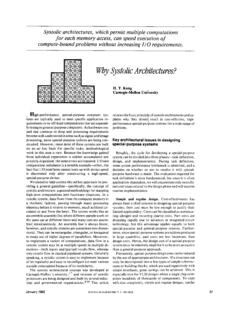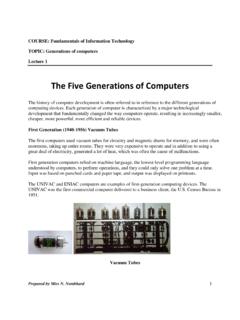Transcription of A Brief History of Operating Systems - Harvard University
1 A Brief History of Operating Systems Learning objectives Develop a framework to think about system functionality and how and why it evolved. Explain how external forces ( , technology and human capital) shape Operating system design and functionality. Speculate realistically about what changes might lie on the horizon for Operating Systems . 1/28/2015 CS161 Spring 2016 1 1/28/2015 CS161 Spring 2016 2 Phase 0: In the beginning Phase 0: No Operating system: 1940-1955 Computers are exotic experimental equipment. Program in machine language.
2 Use plugboards to direct computer. User sits at the console. No overlap between computation, I/O, think time, and response time. Programs manually loaded via card decks. Goal: churn out tables of numbers. Progress: People developed libraries they could share with others. Theses libraries were the precursor to today s Operating Systems . 1/28/2015 CS161 Spring 2016 3 Phase 0: In the beginning Phase 0: No Operating system: 1940-1955 Computers are exotic experimental equipment. Program in machine language. Use plugboards to direct computer.
3 User sits at the console. No overlap between computation, I/O, think time, and response time. Programs manually loaded via card decks. Goal: churn out tables of numbers. Progress: People developed libraries they could share with others. Theses libraries were the precursor to today s Operating Systems . Phase 1: 1955-1970 Computers are expensive; people are cheap Make more efficient use of the computer: move the person away from the machine. OS becomes a batch monitor: a program that loads a user s job, runs it, and then moves on to the next.
4 If program failed, the OS record the contents of memory and saves it somewhere. More efficient use of hardware, but increasingly difficult to debug! 1/28/2015 CS161 Spring 2016 4 Phase 1 Technology Data channels and interrupts: allow overlap of I/O and computation. Buffering and interrupt handling is done by OS. Spool jobs onto high speed drums (cards are slow) Problems Utilization is low (one job at a time). No protection between different jobs. Short jobs wait if they get stuck behind longer jobs. Solutions Hardware to the rescue: memory protection and relocation Multiprogramming: Many users can share the system.
5 Scheduling: Let short jobs finish quickly OS must manage the interaction between concurrent things. OS becomes an important science. OS/360: first OS designed for a family of computers; one Operating system designed to run from smallest to largest machines. 1/28/2015 CS161 Spring 2016 5 Phase 1 Disasters Operating Systems didn t really work! OS/360 was introduced in 1963; worked in 1968. Systems were enormously complicated. They were written in assembly code. No structured programming. Read Fred Brooks: The Mythical Man Month! 1/28/2015 CS161 Spring 2016 6 Phase 2: 1970-1980 Computers and people are expensive Help people be more productive.
6 Interactive timesharing: let many users use the same machine at once. Terminals are cheap: give everyone one ( , Airline system) Keep data on line: use fancy (and not so fancy) file Systems . Attempt to provide reasonable response time (avoid thrashing). Marketplace is driven by vertical applications CTSS: Developed at MIT. One of the first timesharing Systems . Pioneered much of the work in scheduling. Motivated MULTICS. MULTICS: Joint development by MIT, Bell Labs, General Electric. Envisioned one main computer to support everyone.
7 People would buy computing services like electricity. Many, many, many seminal ideas: protected rings, hierarchical file system, devices as files Building it was more difficult than expected. Technology caught up. 1/28/2015 CS161 Spring 2016 7 Phase 2: UNIX Ken Thompson (former Multician) wanted to use an old PDP-7 lying around Bell Labs. He and Dennis Ritchie built a system designed by programmers for programmers. Originally in assembly language. Rewritten by Ritchie and Thompson in C. New idea: portable Operating system! Universities obtained code for experimentation.
8 Berkeley added virtual memory support for the VAX. DARPA selected UNIX as its networking platform (arpanet). UNIX becomes a commercial Operating system. Important ideas popularized by UNIX OS written in a high-level language. OS is portable across hardware platforms. Pipes Mountable file Systems . Many more (take 261 ..) 1/28/2015 CS161 Spring 2016 8 Phase 3: 1980-1990 Computers are cheap; people are expensive. Put a computer in each terminal! CP/M first personal computer Operating system. IBM needed software for their PC s, but CP/M was behind schedule.
9 Approached Bill Gates (Microsoft) to see if they could build one. Gates approached Seattle Computer Products, bought 86-DOS, and created MS-DOS. Primary goal: finish quickly and run existing CP/M programs. OS becomes a subroutine library and command executive. 1/28/2015 CS161 Spring 2016 9 Phase 3 Technologies Personal workstations The PERQ The Xerox Alto The SUN Workstation (Stanford University Network) Personal computers The Apple II The IBM PC The Macintosh Business applications propel the industry Word processors Spreadsheets Databases Marketplace is broken into horizontal markets Hardware Operating Systems Applications 1/28/2015 CS161 Spring 2016 10 Phase 4: Networked Systems (1990-200?)
10 Connectivity is paramount. People want to share data not hardware. Networked applications propel the industry. The Web Email Protection and multiprogramming less important for personal machines. Protection and multiprogramming more important for server machines. Market continues horizontal stratification, add: Internet service providers (service between OS and apps) Information becomes a commodity. Advertising becomes a computer marketplace. New network-based architectures: Clusters Grids Distributed Operating Systems Cloud (or is this a new generation?)







